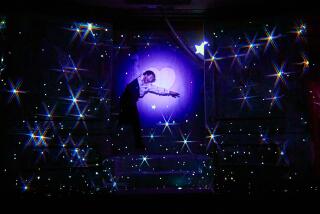From Fear to Redemption--and Back
Flung onto the stage of the John Anson Ford Amphitheatre on Friday like a contemporary Petrushka, Ryan Heffington spent the opening scene of the exciting new abstract dance drama “Sticks and Stones” twitching, trembling and trying desperately to escape.
“Freedom equals fear,” sang Katie Eastburn from the couch she shared with composer Matt Sims, overlooking the action. There would be no escape for Heffington, though over the next two acts (and hours), choreographer Kitty McNamee transformed him from an icon of victimization to a conduit for the group’s self-discovery and sense of belonging.
Some stages of that transformation remained underdeveloped but, in the latest vehicle for McNamee’s Hysterica Dance Company, she displayed an impressive command of nonlinear storytelling, defining character, tracing relationships and reiterating her theme through hot, propulsive confrontations and resolutely avoiding conventional narrative.
Bold gestural motifs helped unify the work: compulsive hair-combing as an index to insecurity, for example, or the dancers seeming to pull open their chests, as if to leave their insides exposed and vulnerable. Initially an expression of Heffington’s pain, this motif eventually grew into a symbol of an openhearted acceptance of life, the only path to freedom without fear.
In style, “Sticks and Stones” used edgy modern dance for intimate passages; Sims’ electronic sounds sometimes seemed to vibrate through the dancers’ bodies, as if they were undergoing shock therapy. (The wiry Heffington proved brilliant in these moments.) Group dances often adopted pop idioms and rock recordings (Siouxsie and the Banshees, for instance), and here the inventively asymmetrical costumes by Grey Ant and Rock ‘N Sissy prioritized delirious nightmare chic.
Heffington’s role gave him major duets with Tara Avise and Erin Giraud, each encounter tinged with a feeling of loss for a different reason. Scott Hislop and Mecca Andrews had their own brief, feisty partnership. But in the duets for R.J. Durell and Lisa Eaton and in particular in the trio for Durell, Eaton and Giraud early in Act 1, McNamee’s ability to physicalize complex emotional undercurrents found its most sensitive and sensual outlet.
Like Heffington’s unstinting fervor, Durell’s partnering prowess served McNamee splendidly throughout the evening. In one duet he swung Eaton onto his shoulder so effortlessly that you assumed there had to be hidden wires a la “Peter Pan.” Avise’s ability to project tension to the next galaxy also allowed McNamee to bypass playacting for deeper in-the-body expression.
Her insights about intimacy proved especially provocative in this depiction of the rootlessness and isolation of contemporary freedom--Eaton wildly struggling in Durell’s embrace, for instance, or submitting to sex with Hislop but not allowing him to kiss her.
The aggressive sexual salesmanship of pop dance thus became dangerously double-edged here: conventionally sexy yet an enticement to exactly what Eaton feared. As a result, casual same-sex linkups seemed less risky, more comfortable for the “Sticks and Stones” women. No possessiveness or, indeed, any future, just slinky momentary gratifications.
Even the feel-good ending, with its communal embraces and those openhearted gestures, arguably represented a pre-sexual or asexual dream of unconditional love and acceptance. When the dream ends, however, Heffington will again be flung, alone and desperate, back into the terrifying void--along with the rest of us.
More to Read
The biggest entertainment stories
Get our big stories about Hollywood, film, television, music, arts, culture and more right in your inbox as soon as they publish.
You may occasionally receive promotional content from the Los Angeles Times.










